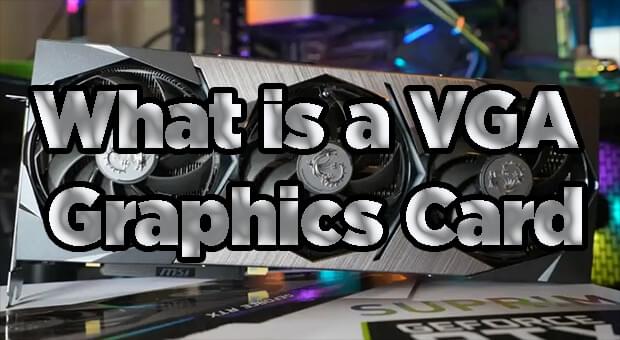In the ever-evolving landscape of computer hardware, one component stands out as a linchpin in the realm of visual computing—the VGA graphics card. Whether you’re a seasoned tech guru or a user, delving into the intricacies of this vital piece of hardware can unlock a deeper understanding of how it contributes to the visual feast that modern computing offers.

Comparison Table About: What is the Difference Between VGA Card Vs Graphics Card –
| Features – | VGA Card | Graphics Card |
|---|---|---|
| Definition | VGA (Video Graphics Array) is a graphics standard introduced by IBM in 1987. | A graphics card is a hardware component that generates and displays images on a monitor. |
| Resolution Support | Limited resolution support, typically up to 640×480 pixels. | Wide range of resolutions, including Full HD (1920×1080) and beyond, depending on the model. |
| Color Depth | Limited color depth, often supporting 16 colors or 256 colors. | Higher color depths, commonly support millions or billions of colors for realistic graphics. |
| Connectivity | Analog VGA connector (DE-15), common in older computers and monitors. | DVI, HDMI, DisplayPort, and newer digital connectors for modern displays. |
| Performance | Basic graphics capabilities are suitable for simple applications and tasks. | High-performance GPUs capable of handling complex 3D rendering, gaming, and professional workloads. |
| 3D Graphics | Limited or no support for 3D graphics rendering. | Advanced 3D graphics capabilities for gaming, 3D modeling, and other intensive tasks. |
| Memory | Limited video memory, typically in the megabyte range. | Dedicated video memory, ranging from megabytes to multiple gigabytes in modern graphics cards. |
| Compatibility | Commonly used in older computers with VGA ports. | Widely compatible with modern computers and supports various interfaces for different monitors. |
| Obsolete | Becoming obsolete as technology advances. | Continuously evolving with advancements in graphics technology. |
What is a VGA Graphics Card?
a) Definition:
Video Graphics Array, abbreviated as VGA, refers to a standard interface that facilitates the connection between computers & displays. A VGA graphics card, also known as a video card or Graphics Processing Unit (GPU), is the heart of this interface, responsible for rendering images and videos to your monitor.
b) Evolution of VGA:
The VGA standard emerged in 1987, introduced by IBM & laid the foundation for subsequent graphics technologies. In its early days, VGA supported a resolution of 640×480 pixels with a palette of 16 colors. Over the years, VGA graphics cards have undergone a transformative journey. Which evolving to support higher resolutions, increased color depths, and advanced graphical features.
Why Do We Need VGA Graphics Cards?
a) Visual Processing Power:
At the core of our need for VGA graphics cards lies the insatiable desire for stunning visuals. These cards are the workhorses behind the scenes, handling the colossal computational tasks associated with rendering graphics. Whether it’s displaying your desktop, streaming a high-definition video, or immersing yourself in the latest blockbuster game, VGA graphics cards ensure a smooth and responsive visual experience.
b) Gaming Performance:
For gamers, the significance of a high-quality VGA graphics card cannot be overstated. The GPU’s ability to process complex graphics in real time directly influences the gaming experience. Modern games, with their intricate textures, realistic lighting, and complex simulations, demand powerful GPUs to deliver an immersive and lifelike gaming environment.
c) Multitasking & Productivity:
Beyond gaming, VGA graphics cards contribute significantly to multitasking and productivity. They empower users to run multiple applications simultaneously, handle resource-intensive tasks like 3D modeling, and support graphics-intensive software such as video editing suites and Computer-Aided Design (CAD) programs.
How Do VGA Graphics Cards Work?
a) Rendering Process:
The primary function of a VGA graphics card is to render images and videos. This intricate process involves several stages, starting with the Central Processing Unit (CPU) sending graphical data to the GPU. The GPU then takes charge, processing this data by applying various algorithms and calculations to create the final image that graces your monitor.
b) Graphics Pipeline:
Modern VGA graphics cards employ a sophisticated graphics pipeline to handle rendering tasks efficiently. This pipeline consists of multiple stages, including geometry processing, rasterization, pixel shading, and finally, output to the display. Each stage plays a crucial role in transforming raw data into the vibrant and dynamic visuals users see on their monitors.
c) Memory Architecture:
An integral aspect of VGA graphics cards is their memory architecture. Dedicated Video Random Access Memory (VRAM) is used to temporarily store graphical data, allowing the GPU quick access to the information it needs. The type and amount of VRAM influence a card’s performance, especially in scenarios where large textures or high-resolution assets need to be processed.
When Should You Upgrade Your VGA Graphics Card?
a) Obsolescence:
As technology marches forward, older VGA graphics cards may struggle to keep pace, rendering them obsolete. If you find your computer struggling with basic tasks or lagging during graphic-intensive activities, it might be a clear signal that it’s time to consider an upgrade.
b) Gaming Requirements:
For avid gamers, staying on the cutting edge often means keeping hardware up to date. Newer games frequently demand more processing power and advanced features that older graphics cards may not support. Upgrading to a more powerful VGA graphics card ensures you can enjoy the latest titles with optimal performance.
c) Workload Changes:
If your computing needs undergo a substantial change, such as starting a new job that involves graphics-intensive tasks or venturing into content creation, upgrading your VGA graphics card can significantly enhance your efficiency. Tasks like video editing, 3D rendering, and graphic design often benefit from a more capable GPU.
Conclusion:
A VGA graphics card is not just a mere component but a fundamental powerhouse that shapes the visual landscape of our computing experiences. From the inception of the VGA standard to the cutting-edge GPUs of today. These devices have evolved to meet the demands of an increasingly visual and immersive digital world.
